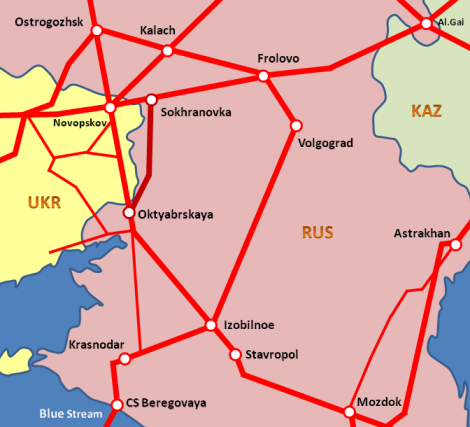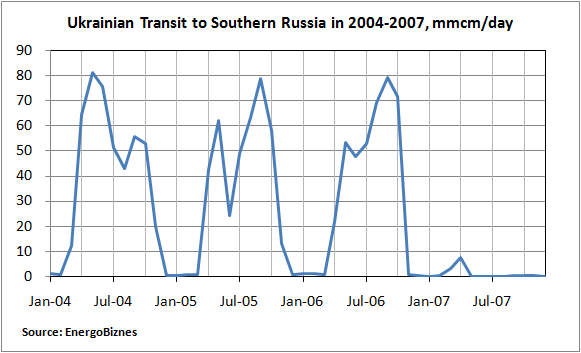|
Responding to
my letter to the Financial Times, Sergei Kuprianov
of Gazprom said that the Sokhranovka-Oktyabrskaya pipeline was
absolutely necessary for the
secure supply of consumers in southern Russia. This is not correct.
Ukrainian transit represented absolutely no risk to consumers in
southern Russia because of the specific seasonal load of the
Ukrainian pipelines in question. The transit flow peaked every
summer, when Gazprom was injecting gas into its huge underground
storage facilities in the south of the country. In winter, storage
gas was delivered to consumers and the transit flow dropped to
nearly zero.

Until 2007, southern
Russia was supplied by local gas production (including the Astrakhan
field) and by gas pipelines from Frolovo, Central Asia (via
Astrakhan) and Novopskov (Ukraine). As shown in the chart below, the
Ukrainian pipeline section between Novopskov and Oktyabrskaya was
loaded from April to October and had an insignificant flow in
winter.

In a hypothetical case
of wintertime interruption of transit flow, Gazprom could easily
replace the lost volume by storage gas. The combined daily
withdrawal rate of the four underground storage facilities in the
Krasnodar and Stavropol regions exceeds 220 million cubic meters (mmcm)
compared to 1 mmcm/day shipped through Ukraine.
A summertime
interruption could not be considered a threat to Russian consumers
neither, because the low summer demand can be met by supplies via
other pipelines and the storage injection period can be extended by
a few weeks. Even in case of complete and permanent closure of
Ukrainian pipelines, there was no risk for the consumers of southern
Russia. Cessation of Russian gas exports to and through Ukraine
would have freed enough pipeline capacity for secure supply of
southern Russia any time of the year.
On the economic side, a
billion-dollar project with a 12%
return can hardly beat an existing alternative that costs $40
million a year. Moreover, Gazprom was able to compensate a part of
the $40 million by the sales of fuel gas burned at the Ukrainian
compressor stations. After the commissioning of the bypass line,
this revenue was transformed into an operating expense because
Gazprom started to burn fuel gas at its own compressor station.
Therefore, the
Sokhranovka-Oktyabrskaya pipeline is an uneconomic project that has
absolutely nothing to do with the security of supply.
Top Russian officials
brand gas transit states as “parasites”. In my view, the
Sokhranovka-Oktyabrskaya project is the first step in the
realization of the "parasite-free" gas export plan of the Kremlin.
As the head of international business department of Gazprom said
about another bypassing pipeline,
the project implementation should proceed regardless of political
and financial conditions. Apparently, money is no object.
Mikhail Korchemkin
East European Gas
Analysis
Malvern, PA, USA
March 9, 2011
|